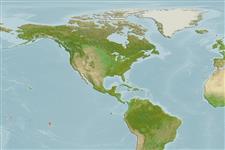Teleostei (teleosts) >
Gobiiformes (Gobies) >
Gobiidae (Gobies) > Gobiinae
Etymology: Stonogobiops: Greek, stonos, -ou = groan + Latin, gobius = gudgeon + Greek, ops = appearance (Ref. 45335).
More on authors: Hoese & Randall.
Environment: milieu / climate zone / depth range / distribution range
Ecology
Marine; demersal; depth range 22 - 35 m (Ref. 397). Tropical; 0°S - 15°S
Eastern Central Pacific: an apparent endemic to the Marquesas Islands.
Size / Weight / Age
Maturity: Lm ? range ? - ? cm
Max length : 5.3 cm SL (female)
Dorsal spines (total): 7; Dorsal soft rays (total): 12; Anal spines: 1; Anal soft rays: 11; Vertebrae: 26. Scales on thorax and pectoral base small and embedded. Eyes and mouth large. Head pores absent. Angle of jaws 40 degrees. Tan in body color with pale spot on each scale; median fins greenish; 2nd dorsal fin with yellowish brown lines; pectoral fins pointed with tan rays, clear membranes; pelvic fins tan. Adults with dark head band ending on upper margin of preoperculum. Longitudinal scale series 100-115, transverse 24-29. 1st to 3rd dorsal spines of adults greatly prolonged. Median predorsal region scaled forward to above preoperculum.
A burrowing species occurring on flat or slightly sloping sand or sand and rubble bottoms. Takes refuge in a burrow constructed by its symbiont alpheid shrimp (a juvenile observed to live with Alpheus randalli). Feeds on small benthic invertebrates (Ref. 89972).
Life cycle and mating behavior
Maturity | Reproduction | Spawning | Eggs | Fecundity | Larvae
Hoese, D.F. and J.E. Randall, 1982. Revision of the Indo-Pacific gobiid fish genus Stonogobiops. Indo-Pac. Fish. (1):18 p. (Ref. 397)
IUCN Red List Status (Ref. 130435: Version 2024-1)
Threat to humans
Harmless
Human uses
Tools
Special reports
Download XML
Internet sources
Estimates based on models
Preferred temperature (Ref.
123201): 28 - 28.2, mean 28.1 °C (based on 4 cells).
Phylogenetic diversity index (Ref.
82804): PD
50 = 0.5078 [Uniqueness, from 0.5 = low to 2.0 = high].
Bayesian length-weight: a=0.01023 (0.00477 - 0.02194), b=3.01 (2.83 - 3.19), in cm total length, based on LWR estimates for this (Sub)family-body shape (Ref.
93245).
Trophic level (Ref.
69278): 3.2 ±0.3 se; based on size and trophs of closest relatives
Resilience (Ref.
120179): High, minimum population doubling time less than 15 months (Preliminary K or Fecundity.).
Fishing Vulnerability (Ref.
59153): Low vulnerability (10 of 100).
